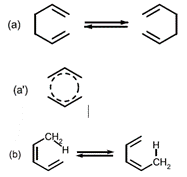ქიმიის ტერმინთა განმარტებითი ლექსიკონი
- ინგლისურ-ქართული
- ქართულ-ინგლისური
- ლექსიკონის შესახებ
- გამოხმაურება

| sigmatropic rearrangement | სიგმატროპული გადაჯგუფება |
| A molecular rearrangement that involves both the creation of a new σ-bond between atoms previously not directly linked and the breaking of an existing σ-bond. There is normally a concurrent relocation of π-bonds in the molecule concerned, but the total number of π- and σ- bonds does not change. The term was originally restricted to intramolecular pericyclic reactions, and many authors use it with this connotation. It is, however, also applied in a more general, purely structural, sense. If such reactions are intramolecular, their transition state may be visualized as an association of two fragments connected at their termini by two partial σ-bonds, one being broken and the other being formed as, for example, the two allyl fragments in (a”). Considering only atoms within the (real or hypothetical) cyclic array undergoing reorganization, if the numbers of these in the two fragments are designated i and j, then the rearrangement is said to be a sigmatropic change of order [i, j] (conventionally [i] ≤[j]). Thus the rearrangement (a) is of order [3,3], whilst reaction (b) is a [1,5]sigmatropic shift of hydrogen.
|
მოლეკულური გადაჯგუფება, რომელიც გულისხმობს როგორც ერთმანეთთან დაუკავშირებელ ატომებს შორის ახალი σ-ბმის წარმოქმნას, ისე არსებული σ-ბმის გაწყვეტას. ჩვეულებრივ, მოლეკულაში ხდება π-ბმების ერთდროული გადაადგილება ისე, რომ π- და σ- ბმების საერთო რაოდენობა არ იცვლება.
ტერმინი თავდაპირველად შემოიფარგლებოდა შიგამოლეკულური პერიციკლური რეაქციებით და ბევრი ავტორი მას იყენებს ამ მნიშვნელობით. თუმცა, ის ასევე გამოიყენება უფრო ზოგადი, წმინდა სტრუქტურული გაგებით. თუ ასეთი რეაქციები შიგამოლეკულურია, მათი გარდამავალი მდგომარეობა შეიძლება ვიზუალურად წარმოვიდგინოთ, როგორც ბოლოებზე ორი ნაწილობრივი σ-ბმით დაკავშირებული ორი ფრაგმენტის ასოციაცია, რომელთაგან ერთი წყდება, ხოლო მეორე - წარმოიქმნება (მაგალითად, ორი ალილის ფრაგმენტი a”-ში). განიხილება მხოლოდ ატომები ციკლური მასივის შიგნით, რომლებიც რეორგანიზაციას განიცდიან. თუ ორ ფრაგმენტში მათი რიცხვი არის i და j, მაშინ გადაჯგუფება ითვლება [i, j] (პირობითად [ i] ≤[j]) რიგის სიგმატროპულ ცვლილებად. ამრიგად, გადაჯგუფება (a) არის [3,3] რიგის, ხოლო რეაქცია (b) არის წყალბადის [1,5] სიგმატროპული გადატანა.
|
| See also: cycloaddition | tautomerism | | ასევე იხილეთ: ციკლომიერთება | ტაუტომერიზმი | |
| Source | წყარო: PAC, 1994, 66, 1077 (Glossary of terms used in physical organic chemistry (IUPAC Recommendations 1994)) on page 1163 |
|










